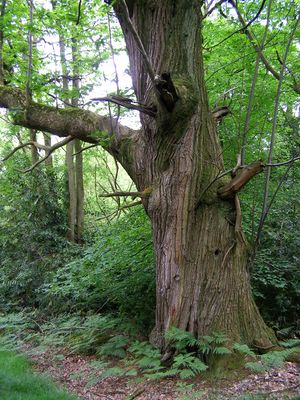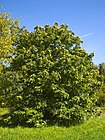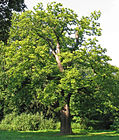Note: This is a project under development. The articles on this wiki are just being initiated and broadly incomplete. You can Help creating new pages.
Castanea sativa - Sweet chestnut
Castanea sativa is a species of Flowering plant in the family Fagaceae. It is native to Europe and Asia Minor. It is widely cultivated throughout the temperate world.
Contents
- 1 Uses
- 2 Parts Used
- 3 Chemical Composition
- 4 Common names
- 5 Properties
- 6 Habit
- 7 Identification
- 8 List of Ayurvedic medicine in which the herb is used
- 9 Where to get the saplings
- 10 Mode of Propagation
- 11 How to plant/cultivate
- 12 Commonly seen growing in areas
- 13 Photo Gallery
- 14 References
- 15 External Links
Uses
Bleeding, Fever, Ague, Cough, Rheumatism, Joint pain, Diarrhea, Sore throats
Parts Used
Chemical Composition
They contained (g/100g dry matter basis) total carbohydrates 75.32 - 86.31, total sugar 10.32 - 22.79, invert sugar 0.08 - 1.25, starch 54.45 - 69.70, sucrose 8.86 - 21.28, ash 1.02 - 3.22, crude cellulose 3.58 - 5.96, total fat 0.49 - 2.01, total protein 4.88 - 10.87[1]
Common names
| Language | Common name |
|---|---|
| Kannada | |
| Hindi | |
| Malayalam | |
| Tamil | |
| Telugu | |
| Marathi | NA |
| Gujarathi | NA |
| Punjabi | NA |
| Kashmiri | NA |
| Sanskrit | |
| English | Sweet chestnu |
Properties
Reference: Dravya - Substance, Rasa - Taste, Guna - Qualities, Veerya - Potency, Vipaka - Post-digesion effect, Karma - Pharmacological activity, Prabhava - Therepeutics.
Dravya
Rasa
Guna
Veerya
Vipaka
Karma
Prabhava
Habit
Identification
Leaf
| Kind | Shape | Feature |
|---|---|---|
| Simple | there is one leaf per node along the stem and the edge of the leaf blade has teeth |
Flower
| Type | Size | Color and composition | Stamen | More information |
|---|---|---|---|---|
| Bisexual | 2-4cm long | brown | 5 | These catkins are 10 to 20 cm long and appear in late June to July |
Fruit
| Type | Size | Mass | Appearance | Seeds | More information |
|---|---|---|---|---|---|
| general | the fruit is dry but does not split open when ripe | the bark of an adult plant is ridged or plated | {{{6}}} |
Other features
List of Ayurvedic medicine in which the herb is used
Where to get the saplings
Mode of Propagation
How to plant/cultivate
Seed - where possible sow the seed as soon as it is ripe in a cold frame or in a seed bed outdoors. The seed must be protected from mice and squirrels. The seed has a short viability and must not be allowed to become dry. It can be stored in a cool place, such as the salad compartment of a fridge, for a few months if it is kept moist, but check regularly for signs of germination. The seed should germinate in late winter or early spring.Prefers a good well-drained slightly acid loam in a sunny position but it also succeeds in dry soils [3]
Commonly seen growing in areas
Mountain area, Temperate region.
Photo Gallery
A tree in Marchin, Belgium
References
External Links
- Ayurvedic Herbs known to be helpful to treat Bleeding
- Ayurvedic Herbs known to be helpful to treat Fever
- Ayurvedic Herbs known to be helpful to treat Ague
- Ayurvedic Herbs known to be helpful to treat Cough
- Ayurvedic Herbs known to be helpful to treat Rheumatism
- Ayurvedic Herbs known to be helpful to treat Joint pain
- Ayurvedic Herbs known to be helpful to treat Diarrhea
- Ayurvedic Herbs known to be helpful to treat Sore throats
- Herbs with Seeds used in medicine
- Herbs with Bark used in medicine
- Herbs with common name in English
- Habit - Tree
- Index of Plants which can be propagated by Seeds
- Index of Plants which can be propagated by Cuttings
- Herbs that are commonly seen in the region of Mountain area
- Herbs that are commonly seen in the region of Temperate region
- Herbs
- Fagaceae














